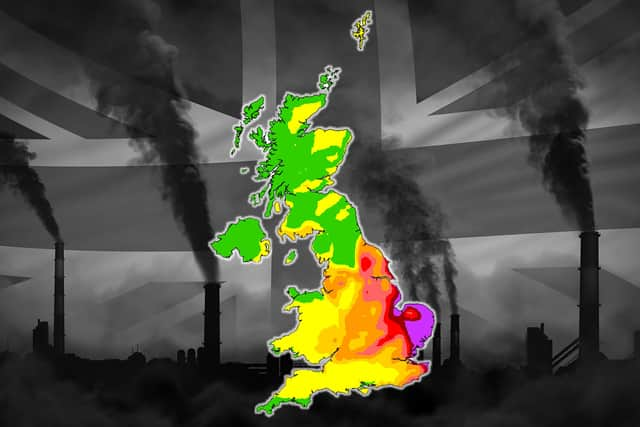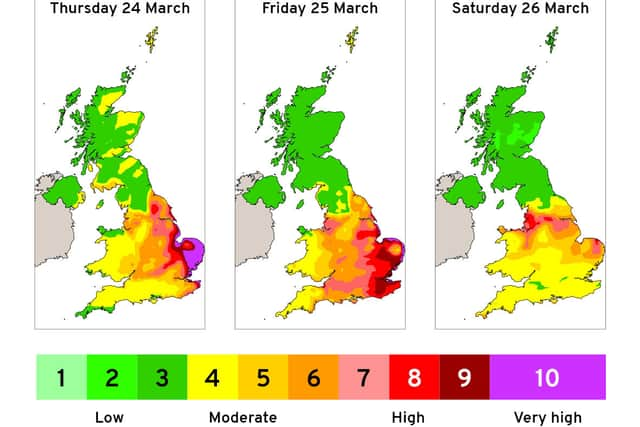What is air pollution? Map of worst-affected areas of UK - and how to check levels today
This article contains affiliate links. We may earn a small commission on items purchased through this article, but that does not affect our editorial judgement.
and live on Freeview channel 276
A ‘very high’ air pollution alert is in place in one area of the UK - while six other regions are recording ‘high’ levels.
Warnings have been issued to people living in Yorkshire and Humberside to avoid strenuous activity outside especially if experiencing a sore throat or cough.
Advertisement
Hide AdAdvertisement
Hide AdOn Friday (25 March) and Saturday (26 March) “moderate” levels of air pollution are forecast across England and Wales with some “high” or locally “very high” levels for parts of eastern and southeast England.
Here are the worst-affected areas in the UK and how you can check air pollution levels where you live.
What is air pollution?
Air pollution is contamination of the indoor or outdoor environment by any chemical, physical or biological agent that changes the natural characteristics of the atmosphere.


Household combustion appliances (ie coal-burning stoves, gas ovens), motor vehicles, industrial facilities and forest fires are common sources of air pollution.
Advertisement
Hide AdAdvertisement
Hide AdPollutants of major public health concern include particulate matter, carbon monoxide, ozone, nitrogen dioxide and sulfur dioxide.
Air pollution can cause respiratory and other diseases and kills an estimated seven million people worldwide every year.
World Health Organisation (WHO) data shows that almost all of the global population (99%) breathe air that contains high levels of pollutants, and exceeds its guideline limits.
Low and middle-income countries suffer from the highest exposure to air pollution.
Advertisement
Hide AdAdvertisement
Hide AdWhat are the worst-affected areas in the UK?
There is currently one region in the UK with ‘very high’ pollution (index 10) and that is Yorkshire and Humberside.
There are also six regions with ‘high’ (index 7, 8 and 9) levels of pollution:
- Eastern
- South East
- East Midlands
- North East
- Greater London
- West Midlands
Air pollution is described on a scale of one to 10, where one corresponds to ‘low’ pollution and 10 corresponds to ‘very high’ pollution using the Daily Air Quality Index (DAQI).
The latest air pollution information is based on results from over 120 automatic monitoring systems which take readings every hour.
Advertisement
Hide AdAdvertisement
Hide AdThere are also over 150 non-automatic monitors which sample air pollution levels on a daily, weekly or monthly basis.
Alerts will be displayed for a 24 hour period after levels have been exceeded.
What are pollution levels like over the next few days?
Friday (25 March) and Saturday (26 March) will be the worst days for air pollution levels.


On Thursday (24 March) there will be areas of ‘moderate’ levels of air pollution across the UK with some ‘high’ or potentially ‘very high’ levels for parts of Eastern and South East England.
Advertisement
Hide AdAdvertisement
Hide AdLower levels of air pollution are likely to be across parts of Scotland and Northern Ireland.
As we head into Friday (25 March) there will be continued areas of ‘moderate’ levels of air pollution across England and Wales.
There will be some high or locally ‘very high’ levels for parts of Eastern and South East England, with ‘low’ levels elsewhere.
On Saturday (26 March) and the next few days, ‘moderate’ levels of air pollution are expected across parts of England and Wales with ‘high’ levels in some urban areas.
Advertisement
Hide AdAdvertisement
Hide Ad‘Low’ levels of air pollution will be likely for Scotland and Northern Ireland.
The Met Office supplies an air quality forecast based on five key pollutants: ozone, nitrogen dioxide, sulphur dioxide, PM2.5 and PM10 particles - which can have an impact on your health.
The forecasts use the Daily Air Quality Index (DAQI) that is designed to show complex air quality information on a simple 10 point scale.
The DAQI uses a combination of numbers (one-10), words (low, moderate, high and very high) and colours (green/yellow/orange/red/purple) to communicate the levels of pollution expected.
Advertisement
Hide AdAdvertisement
Hide AdHow can you check air pollution levels?
New forecasts are produced each morning on the Department of Environment, Food and Rural Affairs (DEFRA) UK Air website.
Air quality forecasts are more uncertain for longer periods but these provide a good outlook of likely future events.
Forecasts are displayed on the UK map but are also available for 5000 specific locations over the UK.
By searching for your postcode, you can see air quality forecasts for the locations of most interest to you.
Advertisement
Hide AdAdvertisement
Hide AdYou can find the DAQI for the area of the UK where you will be spending most time and relate the index value to the health advice.
You can also find out about air pollution forecasts through these ways:
- Freephone 0800556677
- National newspapers
- TV and Radio Weather Forecasts
What are the recommended actions based on the levels of pollution?
For ‘low’ levels of pollution it is advised that you can enjoy your usual outdoor activities, whether you are an at-risk individual or not.
When levels become ‘moderate’, the health message for adults and children with lung or heart problems who experience symptoms, is to consider reducing strenuous exercise and activity particularly outdoors.
Advertisement
Hide AdAdvertisement
Hide AdFor the general population it is advised to enjoy your usual outdoor activities.
For ‘high’ levels of pollution, adults and children with lung problems and heart problems should reduce strenuous physical exertion, particularly outdoors, if they experience symptoms.
People with asthma may find they need to use their reliever inhaler more often. Older people should also reduce physical exertion.
For the general population, anyone experiencing discomfort such as sore eyes, cough or sore throat should consider reducing activity, particularly outdoors.
Advertisement
Hide AdAdvertisement
Hide AdWhen levels reach ‘very high’, adults and children with lung or heart problems, and older people, should avoid strenuous physical activity - with asthmatic people finding they may need to use their reliever inhaler more often.
The general population should reduce physical exertion, particularly outdoors, especially if you experience symptoms such as a cough or sore throat.
A message from the editor:
Thank you for reading. NationalWorld is a new national news brand, produced by a team of journalists, editors, video producers and designers who live and work across the UK. Find out more about who’s who in the team, and our editorial values. We want to start a community among our readers, so please follow us on Facebook, Twitter and Instagram, and keep the conversation going. You can also sign up to our newsletters and get a curated selection of our best reads to your inbox every day.
Comment Guidelines
National World encourages reader discussion on our stories. User feedback, insights and back-and-forth exchanges add a rich layer of context to reporting. Please review our Community Guidelines before commenting.
